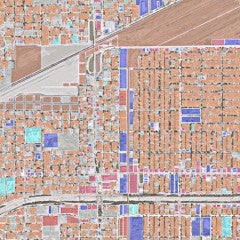A self-admitted “transportation nerd,” Davis is Houston’s director of transportation and drainage operations. And despite the obvious differences between cities, she says whether it is Washington, D.C., Pittsburgh or Houston, they are generally beset by the same fundamental obstacles when it comes to better walkability, bikeability and being able to live without a car.
“People don't want to lose parking. People don't want to be inconvenienced. People don't want traffic, or what they perceive as traffic,” she said.
In “Inclusive Transportation”, Davis advises against dismissing these concerns, but also says doing the right thing for the broader community might often mean doing the unpopular thing.
The Urban Edge spoke with Davis to learn more about how the message of her book applies to the future of transportation in Houston and elsewhere. The conversation has been edited for length and clarity.
(Disclaimer: In this article and her book, Davis’ views do not necessarily reflect those of the City of Houston.)
What values have shaped modern American cities?
When you look at cities like Houston, you can tell a value is given to motor vehicles. When you look at the High Injury Network, it's pretty much the same type of road, a very wide five-, six-, eight-lane road through an area where people are attempting to walk. And that is pretty much any city across this country. That's where you will see high deaths.
When you go to other countries, like Antigua, Guatemala, every Friday, they shut down parts of the city where, if you're not walking, you can't enter that part of the city, because for them walkability is a high priority. In Cali, Colombia, I experienced bus-only streets, like, not a lane — like, we pat ourselves on the back, because we're like, “Hey, we gave the bus one of our 10 lanes.” But in Cali, Colombia, they have entire streets that are only buses. And that shows a value of moving a lot of people very efficiently. And so that's where all of that comes from.
What is it specifically about car-centric cities that make them inequitable and not inclusive to all of their residents?
What makes car-centric cities inequitable, one, it's just the ownership of a car. Even on the lower end, cars are very expensive — gas, insurance, maintenance, finding somewhere to park and paying for that parking, if you get in a crash. So cars are very expensive endeavors versus other modes. So right there, it's placing an inequitable system there.
I think that overall though, even beyond cars, if you look at most transit systems, it's designed for the 9-to-5 worker — lots of high frequency during the morning rush hour where people who need to get to offices need to move, very high frequency during the afternoon rush hour when people in offices need to leave. And so there is still an inequity in how we've designed the system. We focused on getting people to work, but we forget that some people work shifts, and I think that COVID really blew that open, where it's like, “Oh, we don't need these buses anymore. No one's riding.” But the health care workers, the janitorial staff, the restaurant workers and essential workers were left stranded and needed to go somewhere. And I think that it is incumbent upon us to really think about that — that regardless of how you want to move and when you want to move, this mode is available to you.
You highlight how conversations and actions toward equity are not enough to address the root problems in our transportation system. Rather, you say, equity must be prioritized based on need, similar to how an emergency room triages patients. How do you see that work being undertaken in Houston?
The hard part about equity, it really is about prioritization. And it means you might have to tell the community “no” in order to highlight a community that is really in dire need. And it's hard, because everyone feels like their issue is the most important issue or their safety is the most important safety issue. And it's not saying it's not important — it's just we really need to focus.
And then what's even harder and compounded, particularly in diverse cities, like Houston and others, is you may have one Black or brown community that says, “Well, I’m a Black and brown community and equity.” And it's like, “You're right, but there's another Black and brown community over here that is in an even significantly worse position.” And that is where we are trying to focus the resources, because they are in a significantly worse position. And then that becomes a challenge. And it's hard because it takes political savviness and understanding to be able to help people understand that it's not that I don't care about your issue, but I really have this prioritization. And having politicians, frankly, decision-makers depending on the political structure of that city, of being willing to say, “I hear you, and you can make a lot of noise. And you can write a lot and have a lot of letter campaigns, but we're still going to prioritize this.” And that is hard.
You touch on NIMBYs (not in my backyard), or “naysayers” as you describe them, people opposed to new transit projects or housing in their communities, who have increasingly become the subject of much media scrutiny. How can people interested in transportation alternatives tackle or engage with them?
In the end, ignoring them is never going to work. I think that it comes down to, what's the root of the root? I've had projects where people were just mad, but when you actually start asking questions like, “OK, why don't you want this? OK, but why don't you bike?” And you realize that it was people who were actually supportive of the project. They just didn't have a bike or know how to buy, but they were bike curious. And so it was a naysayer, because it's easier for me to say no than to truly examine why I'm saying no. And then full circle back to why I ask the readers [of my book] to look at your personal story because if you don't know yourself, it's very easy to get caught up in these superficial reasons why. But that's not the real reason, the reason’s really, like, five layers deep. And so that's part of that understanding.
The other part of it is responding. So they might throw out different alternatives, and it's important to respond why this alternative will or will not work. They still might not believe you. But at least you've responded that, “Here, I've given you a reason why this will and will not work, here's the data.” And then there's going to be a point where sometimes you're just never going to make them happy. And it gets back to at some point, you have to make a decision. I think that, you know, a lot of times, they're like consensus-building. And if a consultant ever tells you, “We're gonna do consensus-building,” you’re like, “I hear you,” but there's going to be a point where there is no consensus, someone has to make that tough decision of “what are we going to do? And how are we going to move forward?”
You talk a lot in the book about the limitations of current long-range transportation plans for cities and regions. These plans just assume everyone is going to drive in the future, rather than shift to alternative modes of transportation. Do you think that the status quo is changing in regions like Houston in any way?
I think that part of the challenge is that, by federal law, the region has had a long-range plan. And so it goes back to what the regulations are, the guidance of those regulations, and what you get as a result of that guidance and those regulations, and so you do have to run these models that project from where you are today. And so you have all these structures that are set up in a way that don't allow you to make a really good decision. Frankly, and it's not even just to pick on Texas, just a lot of other states, a lot of other cities, a lot of other regions — that's what you're kind of up against.
And you can't get focused on one project. You're going to have to walk and chew gum, and you're really going to have to bring down the overall structure. And in some cases, it may be city policies or the design guidelines. But [the latter is] something you have to start at the national level, because that informs the state, which informs the locals.
What are your hopes in the work you’re doing in Houston? What do you hope can break ground or change in the city over the next five years? What would be your ideal plan for cities like Houston to invest in and aim for by, say, 2050?
So things are changing. And I think that cities are recognizing that they need to do things differently. And I think they're doing their best. I think with the funding that has become available through the Bipartisan Infrastructure Law, we are seeing better projects. And it's because the feds have put the guardrails on what makes a good project. So when you look at the Reconnecting Communities program, that is absolutely huge — that is the recognition of the federal government, that we've made decades of bad decisions and now we need to figure out how to make better decisions. When you look at the Neighborhood Access and Equity [program], it's even getting more localized to neighborhood streets to say, “Yes, we recognize that this neighborhood is really bad, and we need to be better. And here's this federal money for you to make it better.”
And so I think that change is happening, but the feds are saying, “If you competitively want this money, then you competitively need to give us better projects.” And so cities are stepping up and submitting projects that probably they wouldn't have submitted because it's very hard to get funded under the other funding streams. And so you have that big half happening. At the same time, I still think that we're still in this place where state DOTs (departments of transportation) across the country, not just Texas, are still making decisions that are the antithesis of what cities are asking for. And I think that is something that, the next 5-10 years, that's still going to be a battle.
You go into great detail about how to influence and take part in the transportation/urban planning process, but much of it appears to be aimed at those “in the know” already. For a first-timer in Houston who maybe is tired of traffic on their commute or potholes in their sidewalk, what would you advise them to do to make an impact on their community?
Yeah, you know, one of them is every city has a 3-1-1 system, like just start there, at the baseline, at least you've got it on someone's radar, right? That one 3-1-1 call may not make a change, but you've at least gotten on radar to that respective city. The other part of it is you don't have to join other groups. Sometimes it can be as simple as every city may have, like, a bicycle advisory council, or a pedestrian advisory council. Those meetings are generally going to be open to the public. Who wants to go to meetings? No one, but going to the meeting to understand the rhythm, the flow, what's happening, how decisions are getting made. Join advocacy organizations. Almost every city has some level of advocacy and that is out there. So joining those organizations, even if nothing else, just to learn. You know, sometimes it could be as simple as organizing your neighbors next door. Filling out surveys is a little thing that, if you get a survey that asks you your opinion about something, take five minutes to fill it out. I think that people feel like they have to be an “expert.” You don't. You're an expert on your neighborhood. You're an expert on your life, you're an expert on the decisions that you make, and there's always an opportunity to lend your voice to those things.




